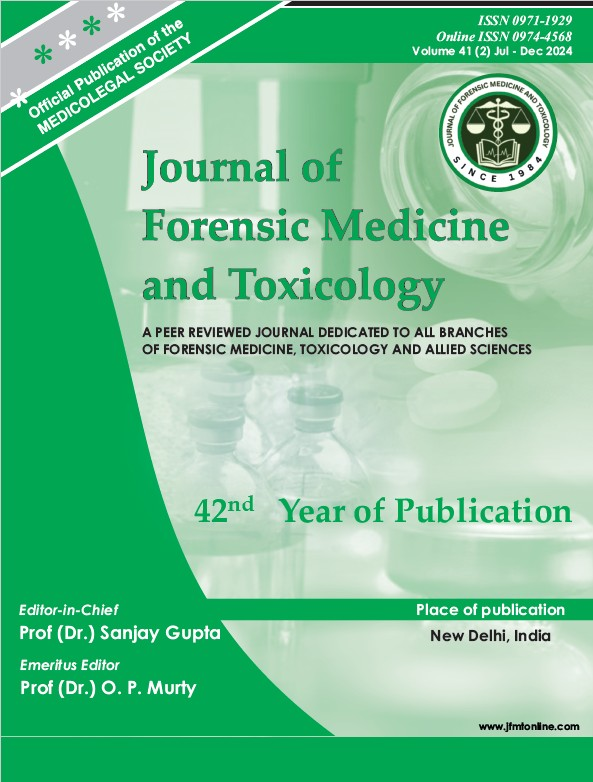SEXUAL DIMORPHISM OF MAXILLARY SINUS DIMENSIONSAND BIZYGOMATIC DISTANCE USING CT SCAN IN THE SOUTHINDIAN POPULATION
DOI:
https://doi.org/10.48165/jfmt.2024.41.1.6Keywords:
Computed tomography (CT), Sexual dimorphism, Maxillary sinus, Bizygomatic distance, IdentificationAbstract
Introduction: Identification of the body remains of an unknown person starts with the identification of the sex and then comes age estimation and further precise identifications. In some instances, like natural calamities, the typically used bones such as the skull and pelvic bones are often recovered in a fragmented or destroyed state, thus interfering with sex determination using them. These special situations demand denser bones like the maxillary sinus and the zygomatic bone to identify sex. This study aims to correlate sexual dimorphism with the maxillary sinus dimensions and the bizygomatic distance. The measurements were done using CT (Computed Tomography) scans of 92 males and 92 females retrieved from PACS (Picture archiving and communication system).
Downloads
References
Tambawala SS, Karjodkar FR, Sansare K, Prakash N. Sexual dimorphism of maxillary sinus using cone beam computed tomography. Egypt J Forensic Sci. 2016;6(2):120-5.
Jehan M, Bhadkaria V, Trivedi A, Sharma SK. Sexual dimorphism of bizygomatic distance & maxillary sinus using CT Scan. IOSR-J Dent Med Sci. 2014;13(3):91-5.
Uthman AT, Al-Rawi NH, Al-Timimi JF. Evaluation of foramen magnum in gender determination using helical CT scanning. DentomaxillofacRadiol. 2012;41(3):197-202.
Dangore-Khasbage S, Bhowate R. Utility of the morphometry of the maxillary sinuses for gender determination by using computed tomography. Dent Med Probl. 2018;55(4):411-7.
Deshpande AA, Munde AD, Mishra SS, Kawsankar KD, Sawade RV, Mandar B. Determination of sexual dimorphism of maxillary sinus using cone-beam computed tomography in a rural population of western Maharashtra - A retrospective, cross-sectional study. J Family Med Prim Care. 2022;11(4):1257-61.
Kanthem RK, Guttikonda VR, Yeluri S, Kumari G. Sex determination using maxillary sinus. J Forensic Dent Sci. 2015;7(2):163-7.
Jeon EY, Ahn HN, Park JT. Sex Determination through 3D Analysis of the Maxillary Sinus. Iran J Public Health. 2022;51(6):1435-7.
Paknahad M, Shahidi S, Zarei Z. Sexual Dimorphism of Maxillary Sinus Dimensions Using Cone-Beam Computed Tomography. J Forensic Sci. 2017;62(2):395- 398. Epub 2016.
Prabhat M, Rai S, Kaur M, Prabhat K, Bhatnagar P, Panjwani S. Computed tomography based forensic gender determination by measuring the size and volume of the maxillary sinuses. J Forensic Dent Sci. 2016 ;8(1):40-6.
Ekizoglu O, Inci E, Hocaoglu E, Sayin I, Kayhan FT, Can IO. The use of maxillary sinus dimensions in gender determination: a thin-slice multidetector computed tomography assisted morphometric study. J Craniofac Surg. 2014;25(3):957-60.
Sahlstrand-Johnson P, Jannert M, Strömbeck A, Abul-Kasim K. Computed tomography measurements of different dimensions of maxillary and frontal sinuses. BMC Med Imaging. 2011;11:8.




